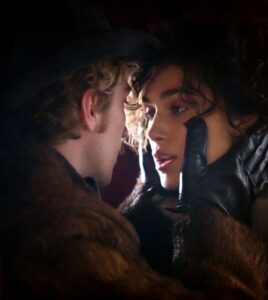The heart wants what the heart wants, as Woody Allen so famously said.
That’s not news to the writers of tragic fiction. Misplaced affection – or the death of one love at the birth of another – is the bedrock of classic tales as diverse as “An American Tragedy” and “Anna Karenina,” opening in limited release Friday (11/16/12).
The latter has now been brought to the screen by Joe Wright, in a film that is both sumptuous and imaginative. With Keira Knightley as the muse, Wright and screenwriter Tom Stoppard transform Tolstoy’s classic into a film that is emotionally wrenching, even as it turns the world it depicts inside out.
Knightley plays Anna, wife of the statesman Karenin (Jude Law), a patient and boring bureaucrat 20 years her senior. They have a child she dotes on and a relatively comfortable life, with a place in St. Petersburg society that Anna relishes.
Then, on a trip to Moscow to help her brother Stiva (Matthew Macfadyen) save his marriage to Dolly (Kelly Macdonald), Anna meets her fate: a handsome cavalry officer and nobleman named Vronsky (Aaron Taylor-Johnson). Vronsky, as it happens, is the passion of Anna’s sister-in-law Kitty (Alicia Vikander), who, in turn, is the object of affection for Levin (Domnhall Gleeson), an aristocratic friend of Steva who chooses to live on and run his family estate in the countryside.
Vronsky ignores Kitty because he is captivated by Anna and so they launch an affair. But doing so in a discreet way is one thing; becoming a public scandal is something else. Before long, Anna finds herself being frozen out of the very society she cherishes and being forced to choose between Vronsky or being able to see her child (which means returning to Karenin).
Wright creates his own metaphor for the world in which these characters live and interact by setting much of the film on the stage and other areas – backstage, lobby, audience – of a 19th-century theater. Scenes are played in sumptuous rooms, but when the camera starts to move, the artifice and façade of the scenery – and the fact that it is on a stage, instead of in a house – become apparent.
This review continues on my website.

